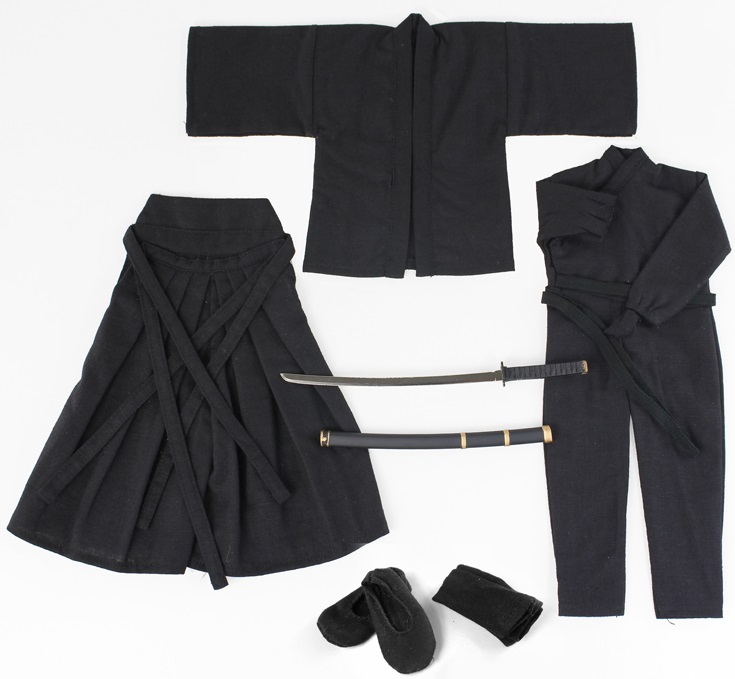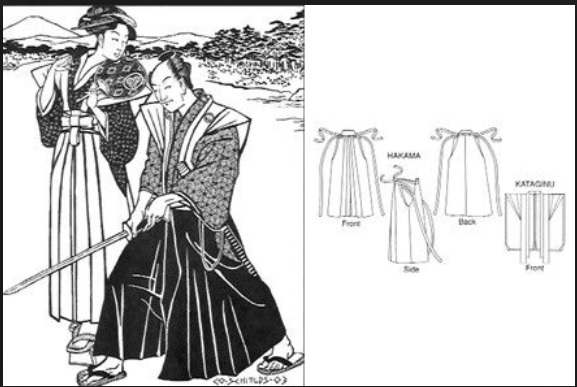
Samurai Clothing
Samurai were the military-nobility and officer-caste of medieval and early-modern Japan. In Japanese, they are usually referred to as bushi (武士?, [bu.ɕi]) or buke (武家?). According to translator William Scott Wilson: "In Chinese, the character 侍 was originally a verb meaning "to wait upon" or "accompany persons" in the upper ranks of society, and this is also true of the original term in Japanese, saburau. In both countries the terms were nominalized to mean "those who serve in close attendance to the nobility", the pronunciation in Japanese changing to saburai. According to Wilson, an early reference to the word "samurai" appears in the Kokin Wakashū (905–914), the first imperial anthology of poems, completed in the first part of the 10th century. By the end of the 12th century, samurai became almost entirely synonymous with bushi, and the word was closely associated with the middle and upper echelons of the warrior class. The samurai were usually associated with a clan and their lord, were trained as officers in military tactics and grand strategy, and they followed a set of rules that later came to be known as the bushidō. While the samurai numbered less than 10% of then Japan's population, their teachings can still be found today in both everyday life and in modern Japanese martial arts.
Fundoshi - 褌 (Fundoshi?) (ふんどし)is the traditional Japanese undergarment for adult males, made from a length of cotton. Before World War II, the fundoshi was the main form of underwear for Japanese adult males. However it fell out of use quickly after the war with the introduction of new underwear to the Japanese market, such as briefs and trunks. Nowadays, the fundoshi is mainly used not as underwear but as festival (matsuri) clothing at Hadaka Matsuri or, sometimes, as swimwear.
Hakama - Hakama (袴?) are a type of traditional Japanese clothing. Trousers were used by the Chinese imperial court in the Sui and Tang dynasties, and this style was adopted by the Japanese in the form of hakama beginning in the sixth century. Hakama are tied at the waist and fall approximately to the ankles. They are worn over a kimono (hakamashita). There are two types of hakama, divided umanori (馬乗り, literally horse-riding hakama) and undivided andon bakama (行灯袴?, lit., lantern hakama). The umanori type have divided legs, similar to trousers. Both these types appear similar. A "mountain" or "field" type of umanori hakama was traditionally worn by field or forest workers. They are looser in the waist and narrower in the leg. Hakama are secured by four straps (himo): two longer himo attached on either side of the front of the garment, and two shorter himo attached on either side of the rear. The rear of the garment has a rigid trapezoidal section, called a koshi-ita (腰板?). Below that on the inside is a hakama-dome (袴止め)[citation needed] (a spoon-shaped component sometimes referred to as a hera) which is tucked into the obi or himo at the rear, and helps to keep the hakama in place. Hakama have seven deep pleats, two on the back and five on the front. The pleats are said to represent the seven virtues of bushido, considered essential to the samurai way. Although they appear balanced, the arrangement of the front pleats (three to the right, two to the left) is asymmetrical, and as such is an example of asymmetry in Japanese aesthetics.
Kyahan - Kyahan (脚絆(きゃはん))are cloth leggings worn by the samurai class and their retainers in feudal Japan. In Japanese the word is also used for western soldier's gaiters. Kyahan were worn as padding underneath the samurai greaves (suneate). Some types of kyahan could be covered with mail armour (kusari kyahan or kyahan suneate), these were worn by foot soldiers ashigaru or by samurai as protection. Kyahan were worn by ordinary travelers as protection from cold, insects and underbrush. Kyahan are often made of linen, but other materials such as cotton can be employed. Kyahan components depend on the season. When tying kyahan, the inner cords are shorter than the outer ones; it is also advisable that the cords are tied on the inner side of the legs instead of on the front or outer area. This helps prevent discomfort when the stiff greaves are placed over the kyahan.
Shitagi - Shitagi (下着?, lit. "under clothing") (also gusoku shita), a type of shirt worn by the Samurai class of feudal Japan when they were wearing full armour. The shitagi was the second garment to be put on, coming second only to the Fundoshi (Japan loincloth). The shitagi was like a short kimono with a button at the neck and an thin attached waist cord (obi). There are several different types of shitagi. The shitagi would be put on as though it were a kimono, the left hand being put first into its sleeve, and then the right, the neck would then buttoned and the waist cord finally tied at the back.
Tabi - Tabi (足袋?) are traditional Japanese socks dating back to the 15th century. Ankle-high and with a separation between the big toe and other toes, they are worn by both men and women with zori, geta, and other traditional thonged footwear. Tabi are also essential with traditional clothing—kimono and other wafuku as well as being worn by samurai in the feudal era.
Uwa-obi - a type of belt/sash that was worn by the samurai class and their retainers in feudal Japan. The uwa-obi was used to attach the sageo (saya cord) of the sword or swords worn by a samurai in order to secure it, other weapons and equipment would be tied to the uwa-obi as well. The uwa-obi was made from linen and cloth made of cotton, it would be wound two to three times around the body when worn. When the uwa-obi was worn with the attire or armour of the samurai, it would first be folded in two, then twisted and then a piece of leather was placed within the centre. This method was used to find the middle of the uwa-obi in a dark area. When putting on the uwa-obi, it was worn with the center in the front of the Dou (dō) (chest armour), then the two ends would be wound around the waist area and back to the front, the uwa-obi would be tied in front rather firmly with the hanamusubi knot.
Waraji - Waraji (草鞋?) are sandals made from straw rope that in the past were the standard footwear of the common people in Japan. Waraji were also worn by the samurai class and foot soldiers (ashigaru) during the feudal era of Japan. Traditionally, the Japanese wear the waraji with their toes protruding slightly over the front edge. However, there are no set rules or guidelines on wearing waraji.
A kasa (笠?) is any of several sorts of traditional hats of Japan. Some of the kasa hats are Amigasa, Jingasa, Sugegasa, Takuhatsugasa and Sandogasa. Amigasa is a traditional straw hat used in some Japanese folk dances. When preceded by a word specifying the type of hat, the word becomes gasa as in the jingasa (war hat). One kind of kasa (Takuhatsugasa) for Buddhist monks is made overlarge, in a bowl or mushroom shape and is made from woven rice straw. It does not come to a point like a rice farmer's hat, nor ride high on the head like a samurai's traveling hat. It is just a big hat covering the upper half to two thirds of the face. Thus, it helps mask the identity of the monk and allows him to travel undistracted by sights around him on his journey. The samurai class of feudal Japan as well as their retainers and footsoldiers (ashigaru) used several types of jingasa made from iron, copper, wood, paper, bamboo or leather.
As far back as the seventh century Japanese warriors wore a form of lamellar armor, this armor eventually evolved into the armor worn by the samurai. The first types of Japanese armors identified as samurai armor were known as yoroi. These early samurai armors were made from small individual scales known as kozane. The kozane were made from either iron or leather and were bound together into small strips, the strips were coated with lacquer to protect the kozane from water. A series of strips of kozane were then laced together with silk or leather lace and formed into a complete chest armor (dou or dō). In the 1500s a new type of armor started to become popular due to the advent of firearms, new fighting tactics and the need for additional protection. The kozane dou made from individual scales was replaced by plate armor. This new armor, which used iron plated dou (dō), was referred to as Tosei-gusoku, or modern armor. Various other components of armor protected the samurai's body. The helmet kabuto was an important part of the samurai's armor. Samurai armor changed and developed as the methods of samurai warfare changed over the centuries. The known last use of samurai armor occurring in 1877 during the satsuma rebellion. As the last samurai rebellion was crushed, Japan modernized its defenses and turned to a national conscription army that used uniforms.

Learn about the fashion industry of Japan in our world of fashion section.
Fashion Products Fashion Products S-Z Fashion Products S
Return to the Influence
Fashion home page.
Copyright 1999-2023 Apparel Search Company. All Rights Reserved.